Offshore Wind Power in Britain: Technology, Impact and Future Report
VerifiedAdded on 2021/06/17
|17
|5578
|447
Report
AI Summary
This report investigates the progress of offshore wind power technology in Britain, highlighting its rapid development and the UK's leading role. It explores the current state of the technology globally and within the UK, emphasizing the impact on the energy system and the transition from fossil fuels. The report delves into current and future technical developments, identifying both opportunities and barriers such as turbine supply and capital sources. It also provides a personal perspective on the technology's viability, concluding with a comprehensive analysis of the UK's commitment to renewable energy targets, the role of offshore wind in meeting these goals, and the challenges that remain in expanding the sector. The report underscores the importance of offshore wind in reducing carbon emissions and the UK's potential to significantly increase its wind energy generation through larger turbines and strategic investments. This report provides insights into the UK's offshore wind power landscape.
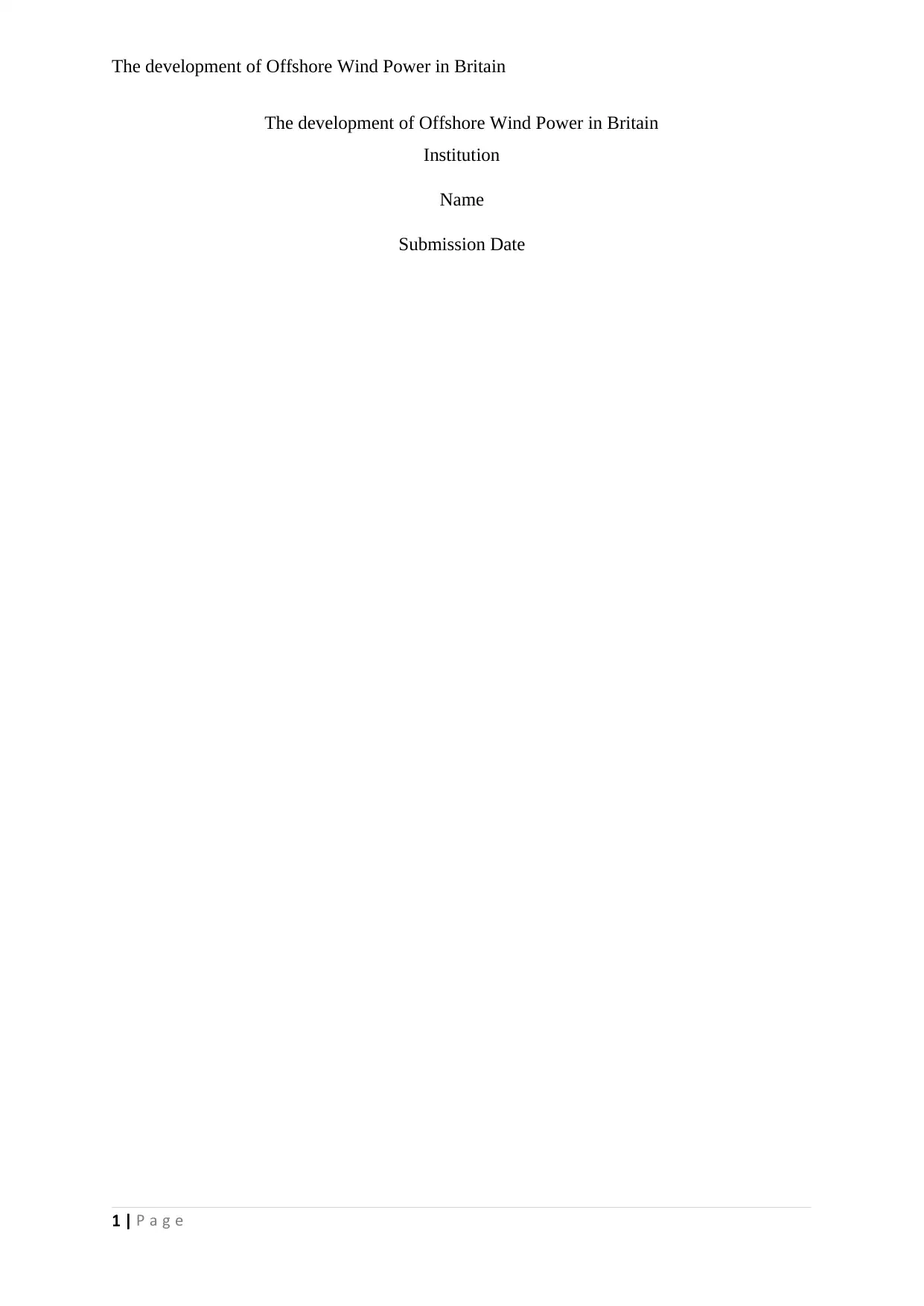
The development of Offshore Wind Power in Britain
The development of Offshore Wind Power in Britain
Institution
Name
Submission Date
1 | P a g e
The development of Offshore Wind Power in Britain
Institution
Name
Submission Date
1 | P a g e
Paraphrase This Document
Need a fresh take? Get an instant paraphrase of this document with our AI Paraphraser

The development of Offshore Wind Power in Britain
Executive Summary
In this research the focus was to investigate the progress that the offshore wind power
technology has made in Britain. Globally it has been seen that the technology has progressed
rapidly. This was earlier stages fronted by Denmark, the US and China. In the past 10-years
UK have made massive developments that have seen it being ranked one of the leading
nations in propelling the technology. The nature of the offshore environment has made it hard
to directly transfer technology from the onshore sector to the offshore sector. This has
discouraged several investors, despite this the UK dedication to meet the EU carbon target
have seen it offer tremendous support to the private sector. This has included availing capital
opportunities as well as passing friendly policies. Through putting to use the massive coast
around the UK the country is in an advantageous position to expand the sector further. The
predictable and a stable politics of the country have also assisted in this development. The
area though I still affected by several challenges; the supply of the turbines, vessel
contraction and insufficient sources of capital are some challenges that still need to be
overcome to ensure proper development of the technology.
2 | P a g e
Executive Summary
In this research the focus was to investigate the progress that the offshore wind power
technology has made in Britain. Globally it has been seen that the technology has progressed
rapidly. This was earlier stages fronted by Denmark, the US and China. In the past 10-years
UK have made massive developments that have seen it being ranked one of the leading
nations in propelling the technology. The nature of the offshore environment has made it hard
to directly transfer technology from the onshore sector to the offshore sector. This has
discouraged several investors, despite this the UK dedication to meet the EU carbon target
have seen it offer tremendous support to the private sector. This has included availing capital
opportunities as well as passing friendly policies. Through putting to use the massive coast
around the UK the country is in an advantageous position to expand the sector further. The
predictable and a stable politics of the country have also assisted in this development. The
area though I still affected by several challenges; the supply of the turbines, vessel
contraction and insufficient sources of capital are some challenges that still need to be
overcome to ensure proper development of the technology.
2 | P a g e
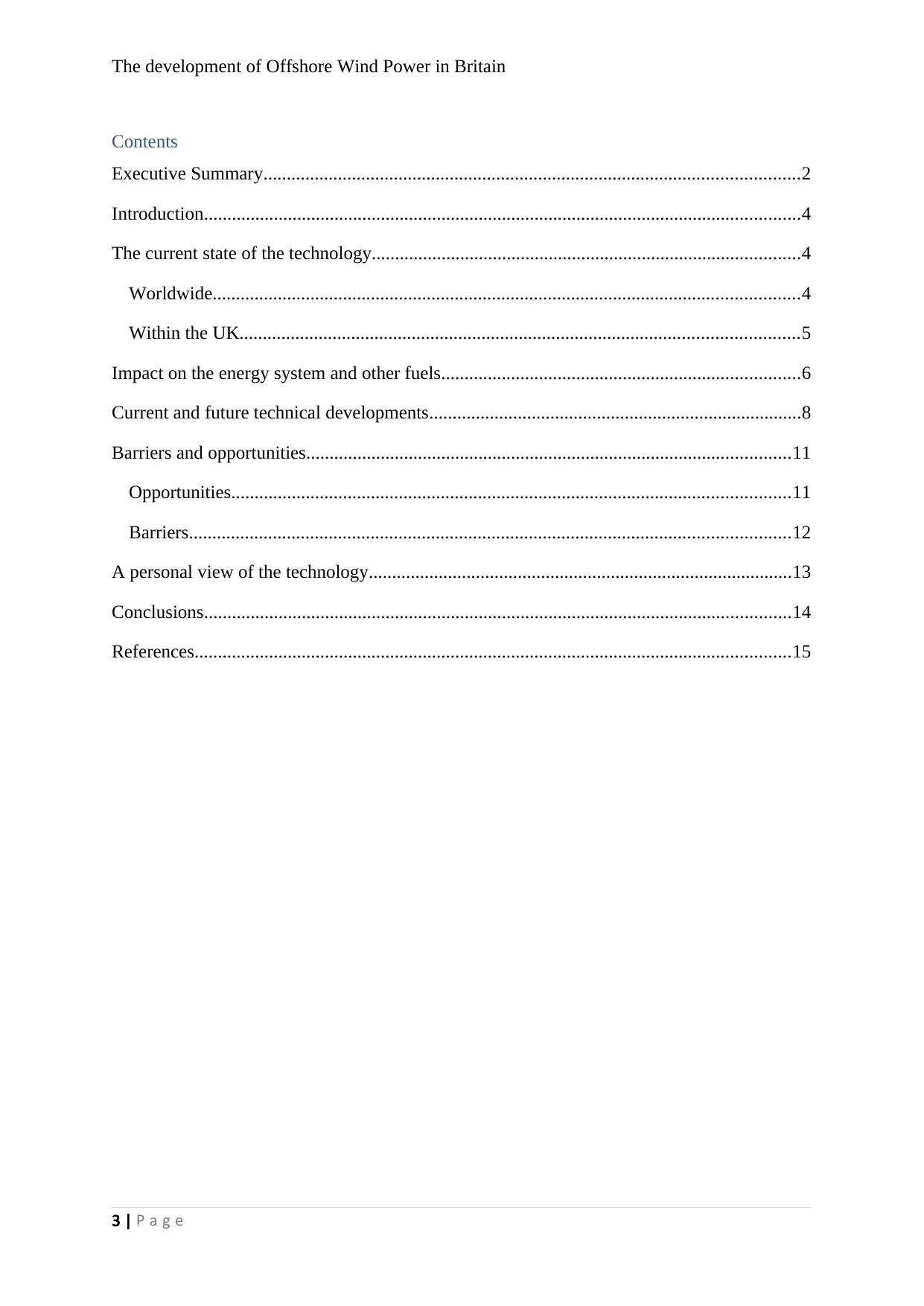
The development of Offshore Wind Power in Britain
Contents
Executive Summary...................................................................................................................2
Introduction................................................................................................................................4
The current state of the technology............................................................................................4
Worldwide..............................................................................................................................4
Within the UK........................................................................................................................5
Impact on the energy system and other fuels.............................................................................6
Current and future technical developments................................................................................8
Barriers and opportunities........................................................................................................11
Opportunities........................................................................................................................11
Barriers.................................................................................................................................12
A personal view of the technology...........................................................................................13
Conclusions..............................................................................................................................14
References................................................................................................................................15
3 | P a g e
Contents
Executive Summary...................................................................................................................2
Introduction................................................................................................................................4
The current state of the technology............................................................................................4
Worldwide..............................................................................................................................4
Within the UK........................................................................................................................5
Impact on the energy system and other fuels.............................................................................6
Current and future technical developments................................................................................8
Barriers and opportunities........................................................................................................11
Opportunities........................................................................................................................11
Barriers.................................................................................................................................12
A personal view of the technology...........................................................................................13
Conclusions..............................................................................................................................14
References................................................................................................................................15
3 | P a g e
⊘ This is a preview!⊘
Do you want full access?
Subscribe today to unlock all pages.

Trusted by 1+ million students worldwide
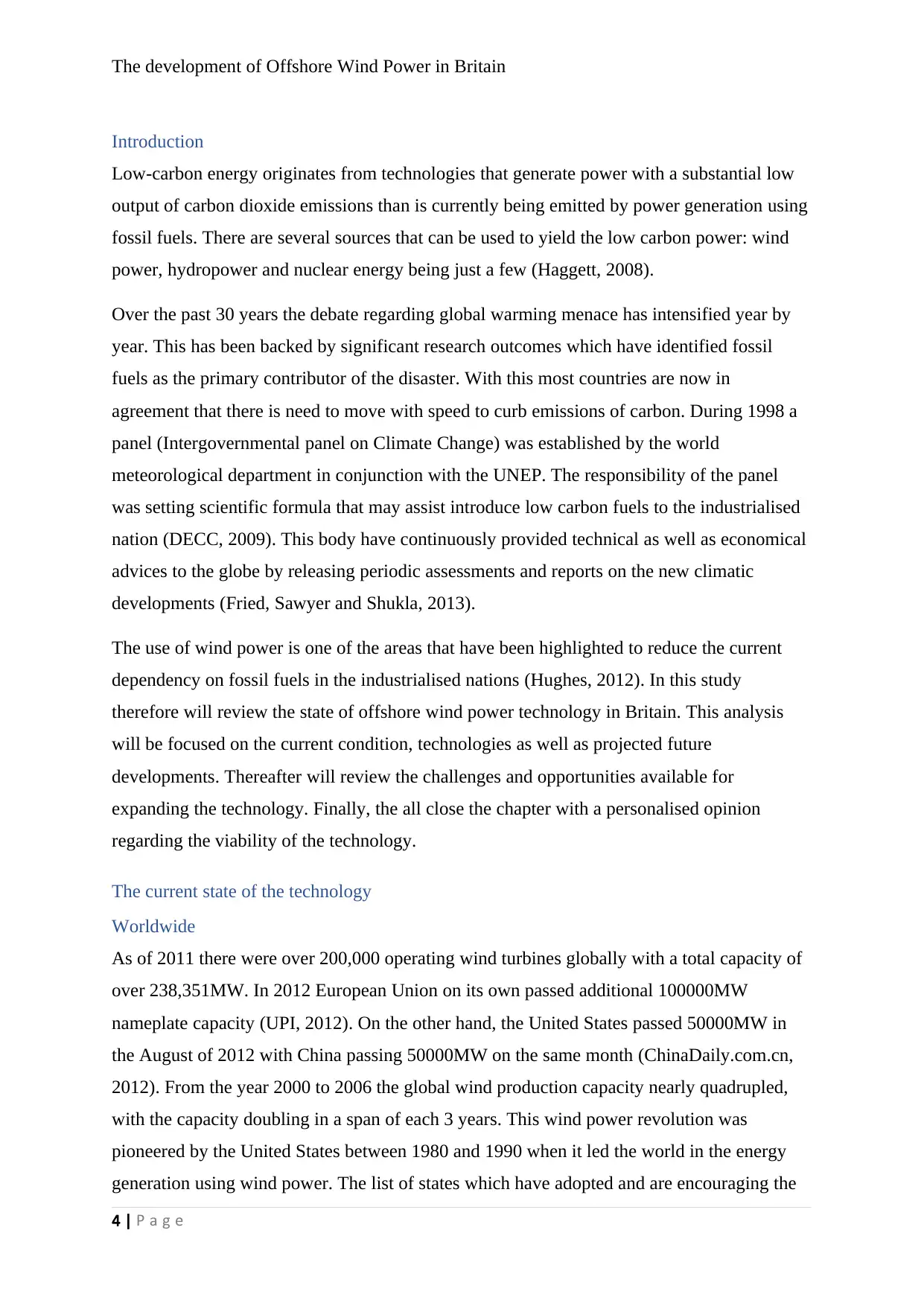
The development of Offshore Wind Power in Britain
Introduction
Low-carbon energy originates from technologies that generate power with a substantial low
output of carbon dioxide emissions than is currently being emitted by power generation using
fossil fuels. There are several sources that can be used to yield the low carbon power: wind
power, hydropower and nuclear energy being just a few (Haggett, 2008).
Over the past 30 years the debate regarding global warming menace has intensified year by
year. This has been backed by significant research outcomes which have identified fossil
fuels as the primary contributor of the disaster. With this most countries are now in
agreement that there is need to move with speed to curb emissions of carbon. During 1998 a
panel (Intergovernmental panel on Climate Change) was established by the world
meteorological department in conjunction with the UNEP. The responsibility of the panel
was setting scientific formula that may assist introduce low carbon fuels to the industrialised
nation (DECC, 2009). This body have continuously provided technical as well as economical
advices to the globe by releasing periodic assessments and reports on the new climatic
developments (Fried, Sawyer and Shukla, 2013).
The use of wind power is one of the areas that have been highlighted to reduce the current
dependency on fossil fuels in the industrialised nations (Hughes, 2012). In this study
therefore will review the state of offshore wind power technology in Britain. This analysis
will be focused on the current condition, technologies as well as projected future
developments. Thereafter will review the challenges and opportunities available for
expanding the technology. Finally, the all close the chapter with a personalised opinion
regarding the viability of the technology.
The current state of the technology
Worldwide
As of 2011 there were over 200,000 operating wind turbines globally with a total capacity of
over 238,351MW. In 2012 European Union on its own passed additional 100000MW
nameplate capacity (UPI, 2012). On the other hand, the United States passed 50000MW in
the August of 2012 with China passing 50000MW on the same month (ChinaDaily.com.cn,
2012). From the year 2000 to 2006 the global wind production capacity nearly quadrupled,
with the capacity doubling in a span of each 3 years. This wind power revolution was
pioneered by the United States between 1980 and 1990 when it led the world in the energy
generation using wind power. The list of states which have adopted and are encouraging the
4 | P a g e
Introduction
Low-carbon energy originates from technologies that generate power with a substantial low
output of carbon dioxide emissions than is currently being emitted by power generation using
fossil fuels. There are several sources that can be used to yield the low carbon power: wind
power, hydropower and nuclear energy being just a few (Haggett, 2008).
Over the past 30 years the debate regarding global warming menace has intensified year by
year. This has been backed by significant research outcomes which have identified fossil
fuels as the primary contributor of the disaster. With this most countries are now in
agreement that there is need to move with speed to curb emissions of carbon. During 1998 a
panel (Intergovernmental panel on Climate Change) was established by the world
meteorological department in conjunction with the UNEP. The responsibility of the panel
was setting scientific formula that may assist introduce low carbon fuels to the industrialised
nation (DECC, 2009). This body have continuously provided technical as well as economical
advices to the globe by releasing periodic assessments and reports on the new climatic
developments (Fried, Sawyer and Shukla, 2013).
The use of wind power is one of the areas that have been highlighted to reduce the current
dependency on fossil fuels in the industrialised nations (Hughes, 2012). In this study
therefore will review the state of offshore wind power technology in Britain. This analysis
will be focused on the current condition, technologies as well as projected future
developments. Thereafter will review the challenges and opportunities available for
expanding the technology. Finally, the all close the chapter with a personalised opinion
regarding the viability of the technology.
The current state of the technology
Worldwide
As of 2011 there were over 200,000 operating wind turbines globally with a total capacity of
over 238,351MW. In 2012 European Union on its own passed additional 100000MW
nameplate capacity (UPI, 2012). On the other hand, the United States passed 50000MW in
the August of 2012 with China passing 50000MW on the same month (ChinaDaily.com.cn,
2012). From the year 2000 to 2006 the global wind production capacity nearly quadrupled,
with the capacity doubling in a span of each 3 years. This wind power revolution was
pioneered by the United States between 1980 and 1990 when it led the world in the energy
generation using wind power. The list of states which have adopted and are encouraging the
4 | P a g e
Paraphrase This Document
Need a fresh take? Get an instant paraphrase of this document with our AI Paraphraser
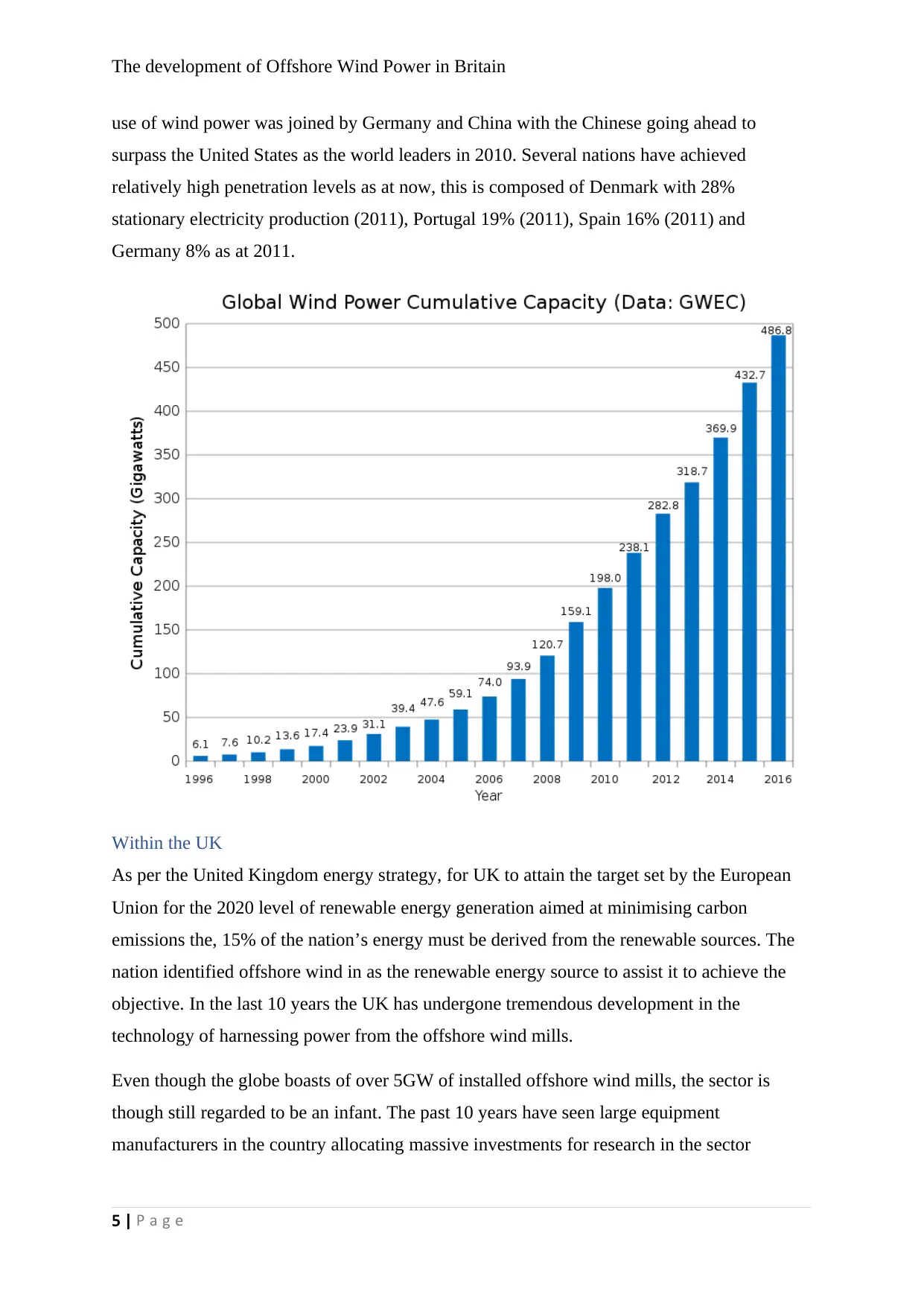
The development of Offshore Wind Power in Britain
use of wind power was joined by Germany and China with the Chinese going ahead to
surpass the United States as the world leaders in 2010. Several nations have achieved
relatively high penetration levels as at now, this is composed of Denmark with 28%
stationary electricity production (2011), Portugal 19% (2011), Spain 16% (2011) and
Germany 8% as at 2011.
Within the UK
As per the United Kingdom energy strategy, for UK to attain the target set by the European
Union for the 2020 level of renewable energy generation aimed at minimising carbon
emissions the, 15% of the nation’s energy must be derived from the renewable sources. The
nation identified offshore wind in as the renewable energy source to assist it to achieve the
objective. In the last 10 years the UK has undergone tremendous development in the
technology of harnessing power from the offshore wind mills.
Even though the globe boasts of over 5GW of installed offshore wind mills, the sector is
though still regarded to be an infant. The past 10 years have seen large equipment
manufacturers in the country allocating massive investments for research in the sector
5 | P a g e
use of wind power was joined by Germany and China with the Chinese going ahead to
surpass the United States as the world leaders in 2010. Several nations have achieved
relatively high penetration levels as at now, this is composed of Denmark with 28%
stationary electricity production (2011), Portugal 19% (2011), Spain 16% (2011) and
Germany 8% as at 2011.
Within the UK
As per the United Kingdom energy strategy, for UK to attain the target set by the European
Union for the 2020 level of renewable energy generation aimed at minimising carbon
emissions the, 15% of the nation’s energy must be derived from the renewable sources. The
nation identified offshore wind in as the renewable energy source to assist it to achieve the
objective. In the last 10 years the UK has undergone tremendous development in the
technology of harnessing power from the offshore wind mills.
Even though the globe boasts of over 5GW of installed offshore wind mills, the sector is
though still regarded to be an infant. The past 10 years have seen large equipment
manufacturers in the country allocating massive investments for research in the sector
5 | P a g e
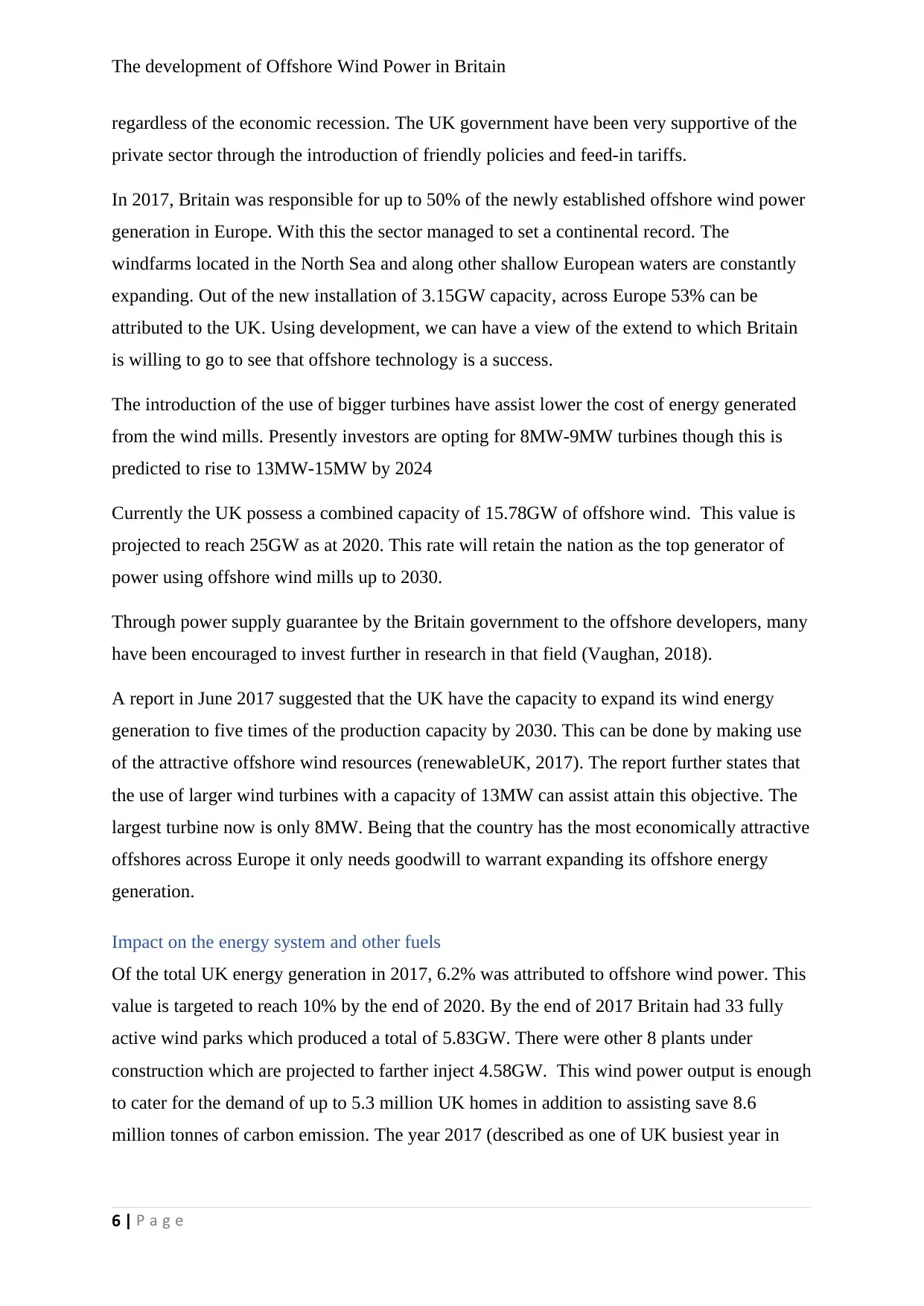
The development of Offshore Wind Power in Britain
regardless of the economic recession. The UK government have been very supportive of the
private sector through the introduction of friendly policies and feed-in tariffs.
In 2017, Britain was responsible for up to 50% of the newly established offshore wind power
generation in Europe. With this the sector managed to set a continental record. The
windfarms located in the North Sea and along other shallow European waters are constantly
expanding. Out of the new installation of 3.15GW capacity, across Europe 53% can be
attributed to the UK. Using development, we can have a view of the extend to which Britain
is willing to go to see that offshore technology is a success.
The introduction of the use of bigger turbines have assist lower the cost of energy generated
from the wind mills. Presently investors are opting for 8MW-9MW turbines though this is
predicted to rise to 13MW-15MW by 2024
Currently the UK possess a combined capacity of 15.78GW of offshore wind. This value is
projected to reach 25GW as at 2020. This rate will retain the nation as the top generator of
power using offshore wind mills up to 2030.
Through power supply guarantee by the Britain government to the offshore developers, many
have been encouraged to invest further in research in that field (Vaughan, 2018).
A report in June 2017 suggested that the UK have the capacity to expand its wind energy
generation to five times of the production capacity by 2030. This can be done by making use
of the attractive offshore wind resources (renewableUK, 2017). The report further states that
the use of larger wind turbines with a capacity of 13MW can assist attain this objective. The
largest turbine now is only 8MW. Being that the country has the most economically attractive
offshores across Europe it only needs goodwill to warrant expanding its offshore energy
generation.
Impact on the energy system and other fuels
Of the total UK energy generation in 2017, 6.2% was attributed to offshore wind power. This
value is targeted to reach 10% by the end of 2020. By the end of 2017 Britain had 33 fully
active wind parks which produced a total of 5.83GW. There were other 8 plants under
construction which are projected to farther inject 4.58GW. This wind power output is enough
to cater for the demand of up to 5.3 million UK homes in addition to assisting save 8.6
million tonnes of carbon emission. The year 2017 (described as one of UK busiest year in
6 | P a g e
regardless of the economic recession. The UK government have been very supportive of the
private sector through the introduction of friendly policies and feed-in tariffs.
In 2017, Britain was responsible for up to 50% of the newly established offshore wind power
generation in Europe. With this the sector managed to set a continental record. The
windfarms located in the North Sea and along other shallow European waters are constantly
expanding. Out of the new installation of 3.15GW capacity, across Europe 53% can be
attributed to the UK. Using development, we can have a view of the extend to which Britain
is willing to go to see that offshore technology is a success.
The introduction of the use of bigger turbines have assist lower the cost of energy generated
from the wind mills. Presently investors are opting for 8MW-9MW turbines though this is
predicted to rise to 13MW-15MW by 2024
Currently the UK possess a combined capacity of 15.78GW of offshore wind. This value is
projected to reach 25GW as at 2020. This rate will retain the nation as the top generator of
power using offshore wind mills up to 2030.
Through power supply guarantee by the Britain government to the offshore developers, many
have been encouraged to invest further in research in that field (Vaughan, 2018).
A report in June 2017 suggested that the UK have the capacity to expand its wind energy
generation to five times of the production capacity by 2030. This can be done by making use
of the attractive offshore wind resources (renewableUK, 2017). The report further states that
the use of larger wind turbines with a capacity of 13MW can assist attain this objective. The
largest turbine now is only 8MW. Being that the country has the most economically attractive
offshores across Europe it only needs goodwill to warrant expanding its offshore energy
generation.
Impact on the energy system and other fuels
Of the total UK energy generation in 2017, 6.2% was attributed to offshore wind power. This
value is targeted to reach 10% by the end of 2020. By the end of 2017 Britain had 33 fully
active wind parks which produced a total of 5.83GW. There were other 8 plants under
construction which are projected to farther inject 4.58GW. This wind power output is enough
to cater for the demand of up to 5.3 million UK homes in addition to assisting save 8.6
million tonnes of carbon emission. The year 2017 (described as one of UK busiest year in
6 | P a g e
⊘ This is a preview!⊘
Do you want full access?
Subscribe today to unlock all pages.

Trusted by 1+ million students worldwide
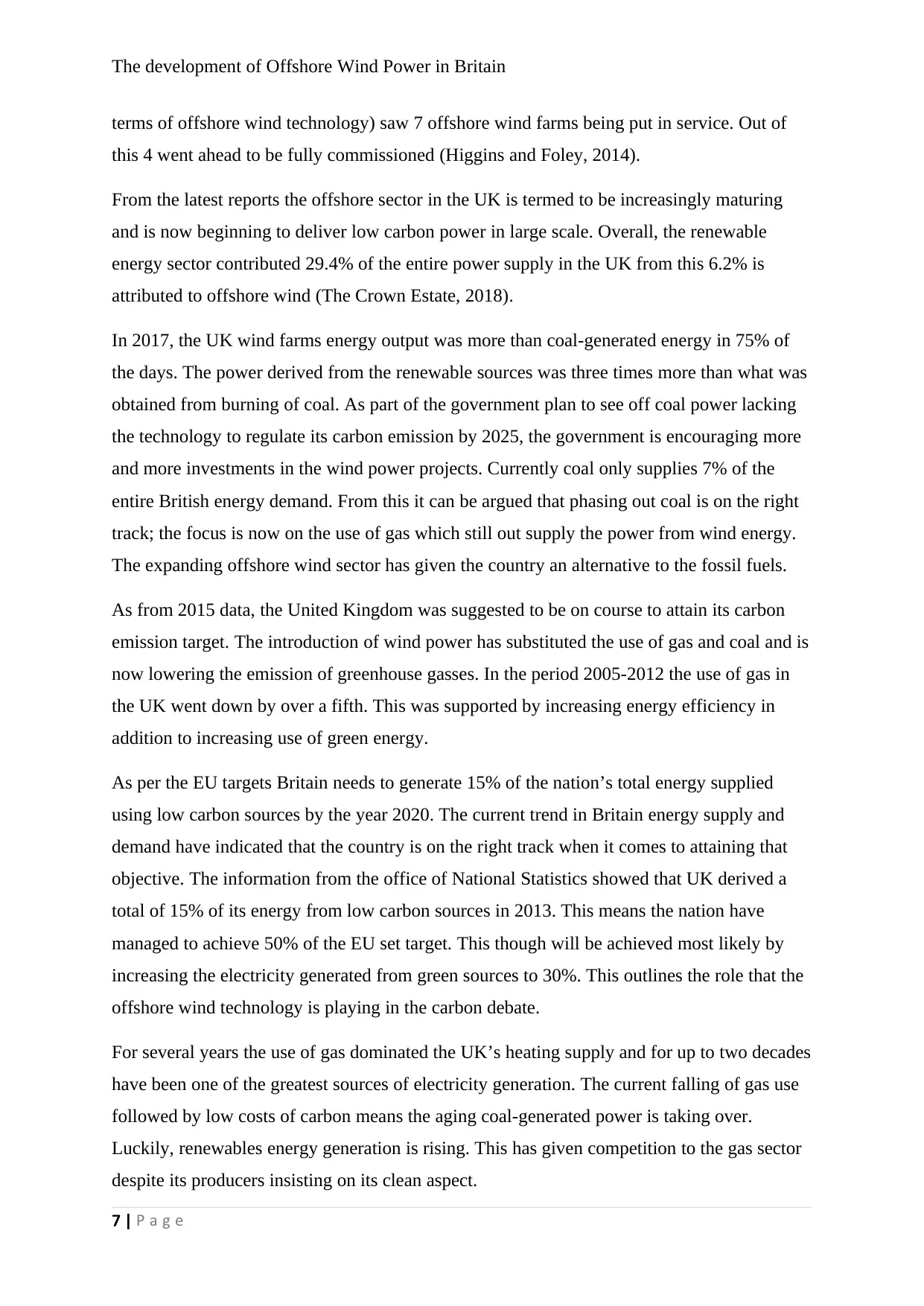
The development of Offshore Wind Power in Britain
terms of offshore wind technology) saw 7 offshore wind farms being put in service. Out of
this 4 went ahead to be fully commissioned (Higgins and Foley, 2014).
From the latest reports the offshore sector in the UK is termed to be increasingly maturing
and is now beginning to deliver low carbon power in large scale. Overall, the renewable
energy sector contributed 29.4% of the entire power supply in the UK from this 6.2% is
attributed to offshore wind (The Crown Estate, 2018).
In 2017, the UK wind farms energy output was more than coal-generated energy in 75% of
the days. The power derived from the renewable sources was three times more than what was
obtained from burning of coal. As part of the government plan to see off coal power lacking
the technology to regulate its carbon emission by 2025, the government is encouraging more
and more investments in the wind power projects. Currently coal only supplies 7% of the
entire British energy demand. From this it can be argued that phasing out coal is on the right
track; the focus is now on the use of gas which still out supply the power from wind energy.
The expanding offshore wind sector has given the country an alternative to the fossil fuels.
As from 2015 data, the United Kingdom was suggested to be on course to attain its carbon
emission target. The introduction of wind power has substituted the use of gas and coal and is
now lowering the emission of greenhouse gasses. In the period 2005-2012 the use of gas in
the UK went down by over a fifth. This was supported by increasing energy efficiency in
addition to increasing use of green energy.
As per the EU targets Britain needs to generate 15% of the nation’s total energy supplied
using low carbon sources by the year 2020. The current trend in Britain energy supply and
demand have indicated that the country is on the right track when it comes to attaining that
objective. The information from the office of National Statistics showed that UK derived a
total of 15% of its energy from low carbon sources in 2013. This means the nation have
managed to achieve 50% of the EU set target. This though will be achieved most likely by
increasing the electricity generated from green sources to 30%. This outlines the role that the
offshore wind technology is playing in the carbon debate.
For several years the use of gas dominated the UK’s heating supply and for up to two decades
have been one of the greatest sources of electricity generation. The current falling of gas use
followed by low costs of carbon means the aging coal-generated power is taking over.
Luckily, renewables energy generation is rising. This has given competition to the gas sector
despite its producers insisting on its clean aspect.
7 | P a g e
terms of offshore wind technology) saw 7 offshore wind farms being put in service. Out of
this 4 went ahead to be fully commissioned (Higgins and Foley, 2014).
From the latest reports the offshore sector in the UK is termed to be increasingly maturing
and is now beginning to deliver low carbon power in large scale. Overall, the renewable
energy sector contributed 29.4% of the entire power supply in the UK from this 6.2% is
attributed to offshore wind (The Crown Estate, 2018).
In 2017, the UK wind farms energy output was more than coal-generated energy in 75% of
the days. The power derived from the renewable sources was three times more than what was
obtained from burning of coal. As part of the government plan to see off coal power lacking
the technology to regulate its carbon emission by 2025, the government is encouraging more
and more investments in the wind power projects. Currently coal only supplies 7% of the
entire British energy demand. From this it can be argued that phasing out coal is on the right
track; the focus is now on the use of gas which still out supply the power from wind energy.
The expanding offshore wind sector has given the country an alternative to the fossil fuels.
As from 2015 data, the United Kingdom was suggested to be on course to attain its carbon
emission target. The introduction of wind power has substituted the use of gas and coal and is
now lowering the emission of greenhouse gasses. In the period 2005-2012 the use of gas in
the UK went down by over a fifth. This was supported by increasing energy efficiency in
addition to increasing use of green energy.
As per the EU targets Britain needs to generate 15% of the nation’s total energy supplied
using low carbon sources by the year 2020. The current trend in Britain energy supply and
demand have indicated that the country is on the right track when it comes to attaining that
objective. The information from the office of National Statistics showed that UK derived a
total of 15% of its energy from low carbon sources in 2013. This means the nation have
managed to achieve 50% of the EU set target. This though will be achieved most likely by
increasing the electricity generated from green sources to 30%. This outlines the role that the
offshore wind technology is playing in the carbon debate.
For several years the use of gas dominated the UK’s heating supply and for up to two decades
have been one of the greatest sources of electricity generation. The current falling of gas use
followed by low costs of carbon means the aging coal-generated power is taking over.
Luckily, renewables energy generation is rising. This has given competition to the gas sector
despite its producers insisting on its clean aspect.
7 | P a g e
Paraphrase This Document
Need a fresh take? Get an instant paraphrase of this document with our AI Paraphraser
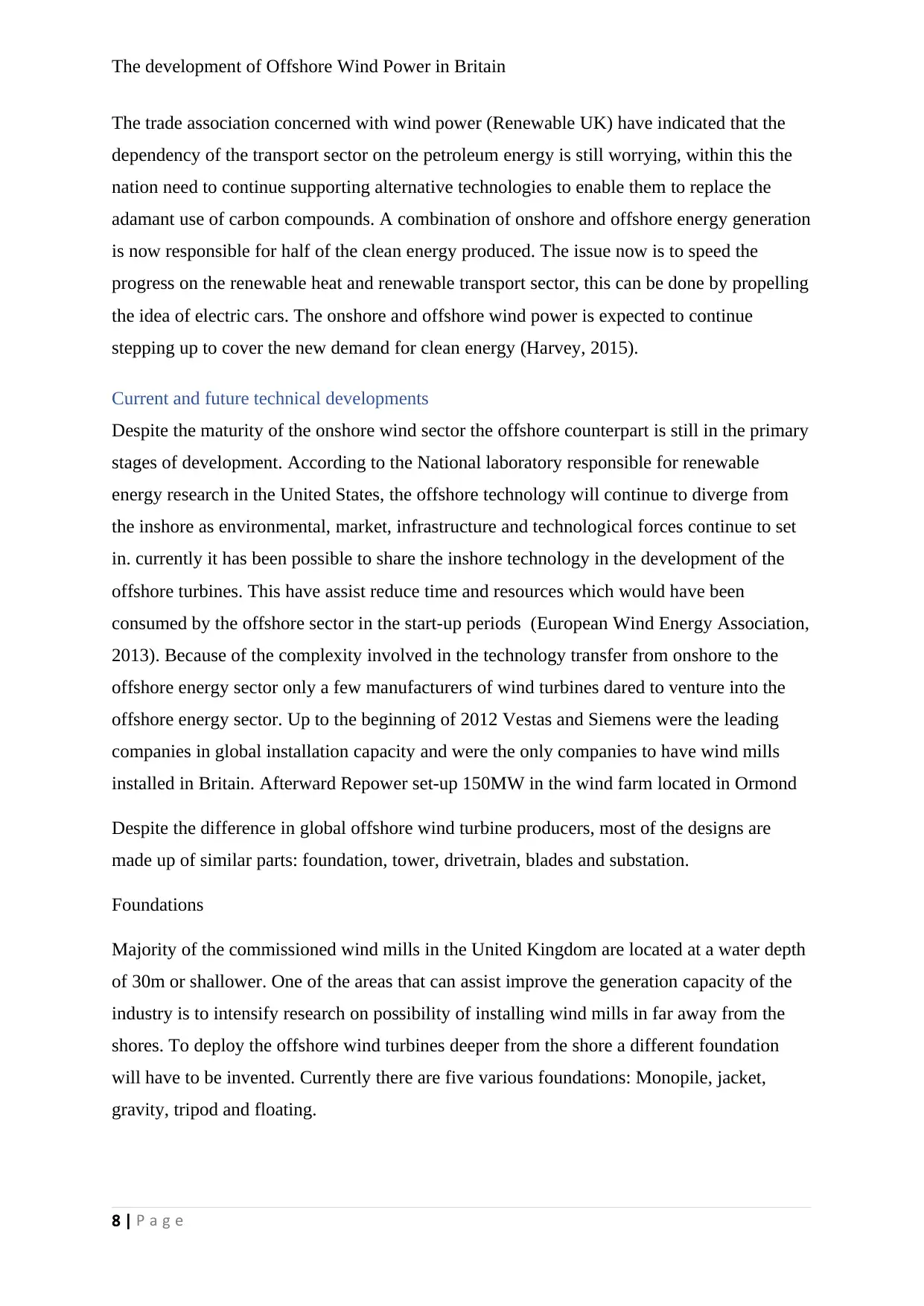
The development of Offshore Wind Power in Britain
The trade association concerned with wind power (Renewable UK) have indicated that the
dependency of the transport sector on the petroleum energy is still worrying, within this the
nation need to continue supporting alternative technologies to enable them to replace the
adamant use of carbon compounds. A combination of onshore and offshore energy generation
is now responsible for half of the clean energy produced. The issue now is to speed the
progress on the renewable heat and renewable transport sector, this can be done by propelling
the idea of electric cars. The onshore and offshore wind power is expected to continue
stepping up to cover the new demand for clean energy (Harvey, 2015).
Current and future technical developments
Despite the maturity of the onshore wind sector the offshore counterpart is still in the primary
stages of development. According to the National laboratory responsible for renewable
energy research in the United States, the offshore technology will continue to diverge from
the inshore as environmental, market, infrastructure and technological forces continue to set
in. currently it has been possible to share the inshore technology in the development of the
offshore turbines. This have assist reduce time and resources which would have been
consumed by the offshore sector in the start-up periods (European Wind Energy Association,
2013). Because of the complexity involved in the technology transfer from onshore to the
offshore energy sector only a few manufacturers of wind turbines dared to venture into the
offshore energy sector. Up to the beginning of 2012 Vestas and Siemens were the leading
companies in global installation capacity and were the only companies to have wind mills
installed in Britain. Afterward Repower set-up 150MW in the wind farm located in Ormond
Despite the difference in global offshore wind turbine producers, most of the designs are
made up of similar parts: foundation, tower, drivetrain, blades and substation.
Foundations
Majority of the commissioned wind mills in the United Kingdom are located at a water depth
of 30m or shallower. One of the areas that can assist improve the generation capacity of the
industry is to intensify research on possibility of installing wind mills in far away from the
shores. To deploy the offshore wind turbines deeper from the shore a different foundation
will have to be invented. Currently there are five various foundations: Monopile, jacket,
gravity, tripod and floating.
8 | P a g e
The trade association concerned with wind power (Renewable UK) have indicated that the
dependency of the transport sector on the petroleum energy is still worrying, within this the
nation need to continue supporting alternative technologies to enable them to replace the
adamant use of carbon compounds. A combination of onshore and offshore energy generation
is now responsible for half of the clean energy produced. The issue now is to speed the
progress on the renewable heat and renewable transport sector, this can be done by propelling
the idea of electric cars. The onshore and offshore wind power is expected to continue
stepping up to cover the new demand for clean energy (Harvey, 2015).
Current and future technical developments
Despite the maturity of the onshore wind sector the offshore counterpart is still in the primary
stages of development. According to the National laboratory responsible for renewable
energy research in the United States, the offshore technology will continue to diverge from
the inshore as environmental, market, infrastructure and technological forces continue to set
in. currently it has been possible to share the inshore technology in the development of the
offshore turbines. This have assist reduce time and resources which would have been
consumed by the offshore sector in the start-up periods (European Wind Energy Association,
2013). Because of the complexity involved in the technology transfer from onshore to the
offshore energy sector only a few manufacturers of wind turbines dared to venture into the
offshore energy sector. Up to the beginning of 2012 Vestas and Siemens were the leading
companies in global installation capacity and were the only companies to have wind mills
installed in Britain. Afterward Repower set-up 150MW in the wind farm located in Ormond
Despite the difference in global offshore wind turbine producers, most of the designs are
made up of similar parts: foundation, tower, drivetrain, blades and substation.
Foundations
Majority of the commissioned wind mills in the United Kingdom are located at a water depth
of 30m or shallower. One of the areas that can assist improve the generation capacity of the
industry is to intensify research on possibility of installing wind mills in far away from the
shores. To deploy the offshore wind turbines deeper from the shore a different foundation
will have to be invented. Currently there are five various foundations: Monopile, jacket,
gravity, tripod and floating.
8 | P a g e

The development of Offshore Wind Power in Britain
Currently the monopile foundation characterises 96% of the wind offshore turbines
commissioned with the jacket foundation taking the other 4%. Based on their design
monopile foundations are effective only for depths of up to 30 m. from here the foundation
losses its natural frequency hence becoming unstable and costly to maintain on deeper water
depths.
The gravity foundations have lower structural limits in comparison with the monopiles
though their cost quickly goes up as the depth increases.
When the sea depth surpasses 30 m the use of jacket and tripod is recommended as they
possess a wider structural base which can be effective in neutralising the strengths of the
wave forces.
In 2009 Statoil installed the a fully floating turbine at water depth of 220 m first full-scale
floating turbine at a depth of 220m. currently several floating turbines are under testing.
Drivetrain
The Siemens is the leading deployer of wind turbines in Britain with Vestas also heavily
investing in the sector. Considering that research puts the gear failure to be at the front of
operational deficiencies there is need to do away with the gearbox so at to cut on the turbines
maintenance costs. The offshore industry is yet to settle on a preferred drive train being that
several technologies are still coming up. The British government have greatly contributed to
the research with the energy department awarding numerous project funding’s to assist
improve the efficiency of the wind mills being developed (Zhang, Verma and Kusiak, 2012).
Towers
Technological innovations have seen the wind turbine towers improve to contain specially
coated materials aimed at withstanding the corrosive nature of the seawater. The rate of
corrosion is very high in the sea water compared to that affecting the onshore turbines, this
has seen the standard of the offshore turbines being established to minimise the high
corrosion. The varying nature of the sea corrosiveness do differ depending on the areas where
the turbines are installed. As an increasing number of manufacturers develop port assembly
as well as facilities for manufacturing, there is hopes of achieving manufacture of a single
section lengths. This will eliminate the desire for multiple tower lifts and minimise the
demand for numerous assembly connections. The increasing wind turbine capacities
requiring stronger and taller towers will generate a transportation issue, this has triggered the
9 | P a g e
Currently the monopile foundation characterises 96% of the wind offshore turbines
commissioned with the jacket foundation taking the other 4%. Based on their design
monopile foundations are effective only for depths of up to 30 m. from here the foundation
losses its natural frequency hence becoming unstable and costly to maintain on deeper water
depths.
The gravity foundations have lower structural limits in comparison with the monopiles
though their cost quickly goes up as the depth increases.
When the sea depth surpasses 30 m the use of jacket and tripod is recommended as they
possess a wider structural base which can be effective in neutralising the strengths of the
wave forces.
In 2009 Statoil installed the a fully floating turbine at water depth of 220 m first full-scale
floating turbine at a depth of 220m. currently several floating turbines are under testing.
Drivetrain
The Siemens is the leading deployer of wind turbines in Britain with Vestas also heavily
investing in the sector. Considering that research puts the gear failure to be at the front of
operational deficiencies there is need to do away with the gearbox so at to cut on the turbines
maintenance costs. The offshore industry is yet to settle on a preferred drive train being that
several technologies are still coming up. The British government have greatly contributed to
the research with the energy department awarding numerous project funding’s to assist
improve the efficiency of the wind mills being developed (Zhang, Verma and Kusiak, 2012).
Towers
Technological innovations have seen the wind turbine towers improve to contain specially
coated materials aimed at withstanding the corrosive nature of the seawater. The rate of
corrosion is very high in the sea water compared to that affecting the onshore turbines, this
has seen the standard of the offshore turbines being established to minimise the high
corrosion. The varying nature of the sea corrosiveness do differ depending on the areas where
the turbines are installed. As an increasing number of manufacturers develop port assembly
as well as facilities for manufacturing, there is hopes of achieving manufacture of a single
section lengths. This will eliminate the desire for multiple tower lifts and minimise the
demand for numerous assembly connections. The increasing wind turbine capacities
requiring stronger and taller towers will generate a transportation issue, this has triggered the
9 | P a g e
⊘ This is a preview!⊘
Do you want full access?
Subscribe today to unlock all pages.

Trusted by 1+ million students worldwide
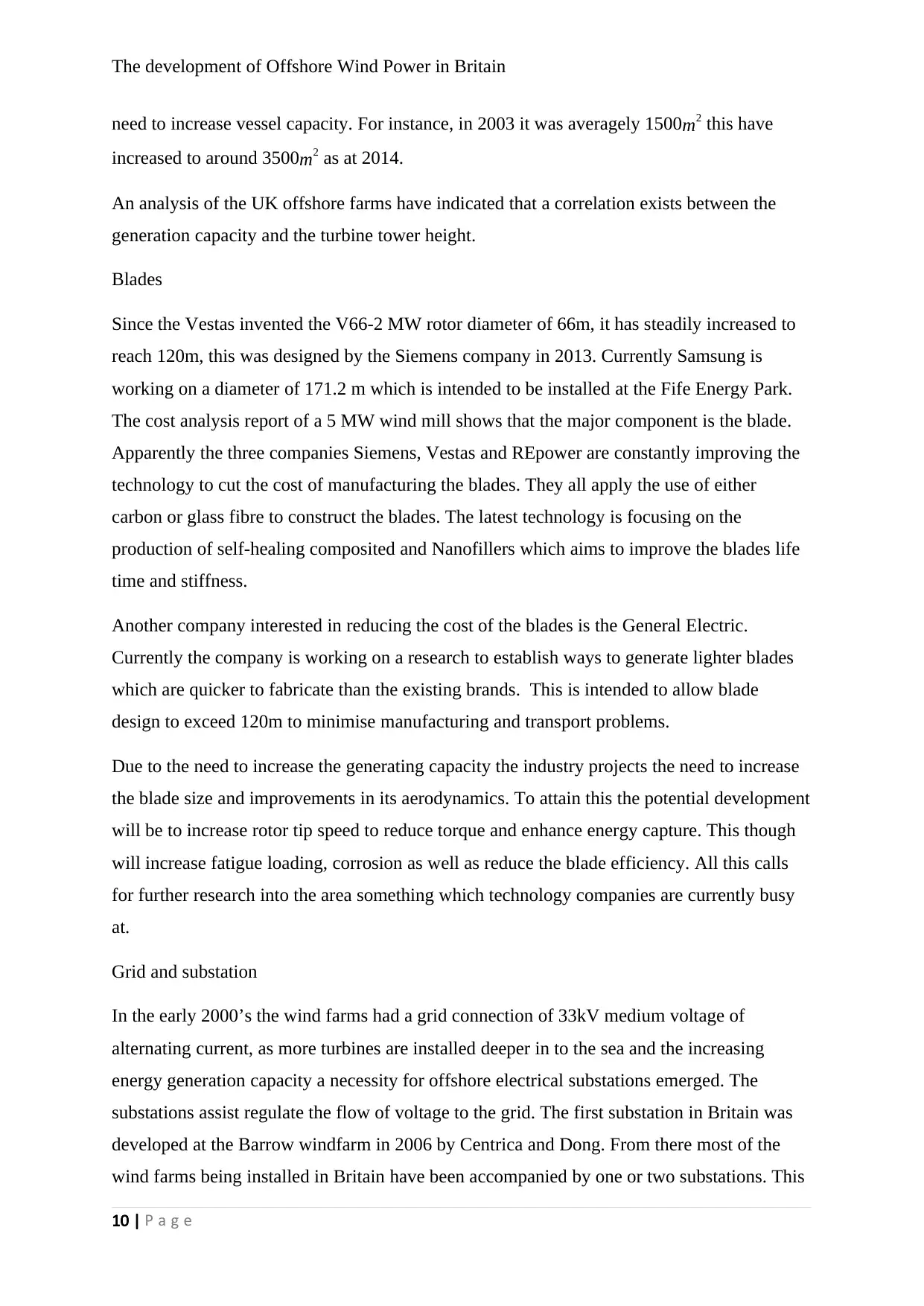
The development of Offshore Wind Power in Britain
need to increase vessel capacity. For instance, in 2003 it was averagely 1500 m2 this have
increased to around 3500 m2 as at 2014.
An analysis of the UK offshore farms have indicated that a correlation exists between the
generation capacity and the turbine tower height.
Blades
Since the Vestas invented the V66-2 MW rotor diameter of 66m, it has steadily increased to
reach 120m, this was designed by the Siemens company in 2013. Currently Samsung is
working on a diameter of 171.2 m which is intended to be installed at the Fife Energy Park.
The cost analysis report of a 5 MW wind mill shows that the major component is the blade.
Apparently the three companies Siemens, Vestas and REpower are constantly improving the
technology to cut the cost of manufacturing the blades. They all apply the use of either
carbon or glass fibre to construct the blades. The latest technology is focusing on the
production of self-healing composited and Nanofillers which aims to improve the blades life
time and stiffness.
Another company interested in reducing the cost of the blades is the General Electric.
Currently the company is working on a research to establish ways to generate lighter blades
which are quicker to fabricate than the existing brands. This is intended to allow blade
design to exceed 120m to minimise manufacturing and transport problems.
Due to the need to increase the generating capacity the industry projects the need to increase
the blade size and improvements in its aerodynamics. To attain this the potential development
will be to increase rotor tip speed to reduce torque and enhance energy capture. This though
will increase fatigue loading, corrosion as well as reduce the blade efficiency. All this calls
for further research into the area something which technology companies are currently busy
at.
Grid and substation
In the early 2000’s the wind farms had a grid connection of 33kV medium voltage of
alternating current, as more turbines are installed deeper in to the sea and the increasing
energy generation capacity a necessity for offshore electrical substations emerged. The
substations assist regulate the flow of voltage to the grid. The first substation in Britain was
developed at the Barrow windfarm in 2006 by Centrica and Dong. From there most of the
wind farms being installed in Britain have been accompanied by one or two substations. This
10 | P a g e
need to increase vessel capacity. For instance, in 2003 it was averagely 1500 m2 this have
increased to around 3500 m2 as at 2014.
An analysis of the UK offshore farms have indicated that a correlation exists between the
generation capacity and the turbine tower height.
Blades
Since the Vestas invented the V66-2 MW rotor diameter of 66m, it has steadily increased to
reach 120m, this was designed by the Siemens company in 2013. Currently Samsung is
working on a diameter of 171.2 m which is intended to be installed at the Fife Energy Park.
The cost analysis report of a 5 MW wind mill shows that the major component is the blade.
Apparently the three companies Siemens, Vestas and REpower are constantly improving the
technology to cut the cost of manufacturing the blades. They all apply the use of either
carbon or glass fibre to construct the blades. The latest technology is focusing on the
production of self-healing composited and Nanofillers which aims to improve the blades life
time and stiffness.
Another company interested in reducing the cost of the blades is the General Electric.
Currently the company is working on a research to establish ways to generate lighter blades
which are quicker to fabricate than the existing brands. This is intended to allow blade
design to exceed 120m to minimise manufacturing and transport problems.
Due to the need to increase the generating capacity the industry projects the need to increase
the blade size and improvements in its aerodynamics. To attain this the potential development
will be to increase rotor tip speed to reduce torque and enhance energy capture. This though
will increase fatigue loading, corrosion as well as reduce the blade efficiency. All this calls
for further research into the area something which technology companies are currently busy
at.
Grid and substation
In the early 2000’s the wind farms had a grid connection of 33kV medium voltage of
alternating current, as more turbines are installed deeper in to the sea and the increasing
energy generation capacity a necessity for offshore electrical substations emerged. The
substations assist regulate the flow of voltage to the grid. The first substation in Britain was
developed at the Barrow windfarm in 2006 by Centrica and Dong. From there most of the
wind farms being installed in Britain have been accompanied by one or two substations. This
10 | P a g e
Paraphrase This Document
Need a fresh take? Get an instant paraphrase of this document with our AI Paraphraser
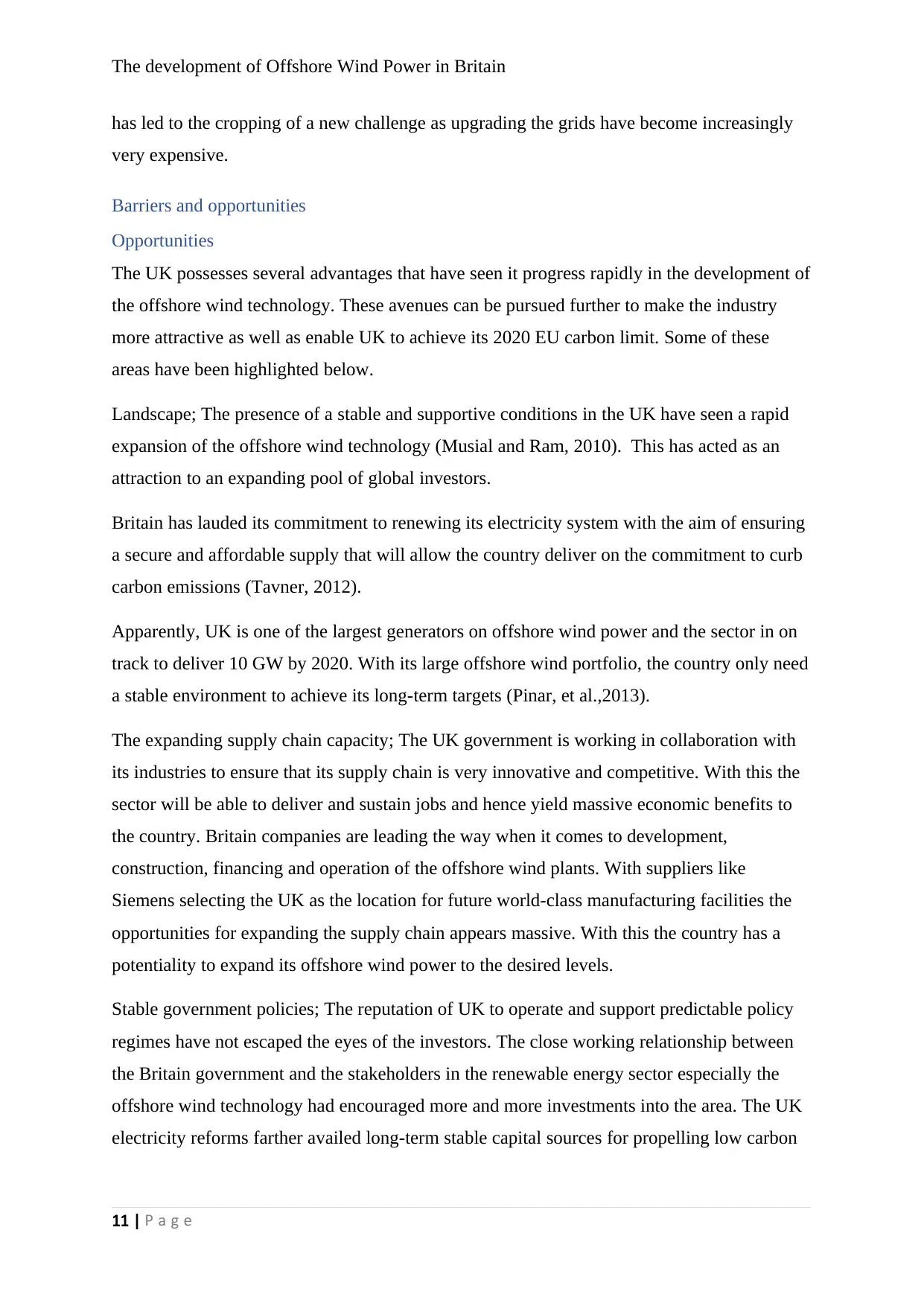
The development of Offshore Wind Power in Britain
has led to the cropping of a new challenge as upgrading the grids have become increasingly
very expensive.
Barriers and opportunities
Opportunities
The UK possesses several advantages that have seen it progress rapidly in the development of
the offshore wind technology. These avenues can be pursued further to make the industry
more attractive as well as enable UK to achieve its 2020 EU carbon limit. Some of these
areas have been highlighted below.
Landscape; The presence of a stable and supportive conditions in the UK have seen a rapid
expansion of the offshore wind technology (Musial and Ram, 2010). This has acted as an
attraction to an expanding pool of global investors.
Britain has lauded its commitment to renewing its electricity system with the aim of ensuring
a secure and affordable supply that will allow the country deliver on the commitment to curb
carbon emissions (Tavner, 2012).
Apparently, UK is one of the largest generators on offshore wind power and the sector in on
track to deliver 10 GW by 2020. With its large offshore wind portfolio, the country only need
a stable environment to achieve its long-term targets (Pinar, et al.,2013).
The expanding supply chain capacity; The UK government is working in collaboration with
its industries to ensure that its supply chain is very innovative and competitive. With this the
sector will be able to deliver and sustain jobs and hence yield massive economic benefits to
the country. Britain companies are leading the way when it comes to development,
construction, financing and operation of the offshore wind plants. With suppliers like
Siemens selecting the UK as the location for future world-class manufacturing facilities the
opportunities for expanding the supply chain appears massive. With this the country has a
potentiality to expand its offshore wind power to the desired levels.
Stable government policies; The reputation of UK to operate and support predictable policy
regimes have not escaped the eyes of the investors. The close working relationship between
the Britain government and the stakeholders in the renewable energy sector especially the
offshore wind technology had encouraged more and more investments into the area. The UK
electricity reforms farther availed long-term stable capital sources for propelling low carbon
11 | P a g e
has led to the cropping of a new challenge as upgrading the grids have become increasingly
very expensive.
Barriers and opportunities
Opportunities
The UK possesses several advantages that have seen it progress rapidly in the development of
the offshore wind technology. These avenues can be pursued further to make the industry
more attractive as well as enable UK to achieve its 2020 EU carbon limit. Some of these
areas have been highlighted below.
Landscape; The presence of a stable and supportive conditions in the UK have seen a rapid
expansion of the offshore wind technology (Musial and Ram, 2010). This has acted as an
attraction to an expanding pool of global investors.
Britain has lauded its commitment to renewing its electricity system with the aim of ensuring
a secure and affordable supply that will allow the country deliver on the commitment to curb
carbon emissions (Tavner, 2012).
Apparently, UK is one of the largest generators on offshore wind power and the sector in on
track to deliver 10 GW by 2020. With its large offshore wind portfolio, the country only need
a stable environment to achieve its long-term targets (Pinar, et al.,2013).
The expanding supply chain capacity; The UK government is working in collaboration with
its industries to ensure that its supply chain is very innovative and competitive. With this the
sector will be able to deliver and sustain jobs and hence yield massive economic benefits to
the country. Britain companies are leading the way when it comes to development,
construction, financing and operation of the offshore wind plants. With suppliers like
Siemens selecting the UK as the location for future world-class manufacturing facilities the
opportunities for expanding the supply chain appears massive. With this the country has a
potentiality to expand its offshore wind power to the desired levels.
Stable government policies; The reputation of UK to operate and support predictable policy
regimes have not escaped the eyes of the investors. The close working relationship between
the Britain government and the stakeholders in the renewable energy sector especially the
offshore wind technology had encouraged more and more investments into the area. The UK
electricity reforms farther availed long-term stable capital sources for propelling low carbon
11 | P a g e
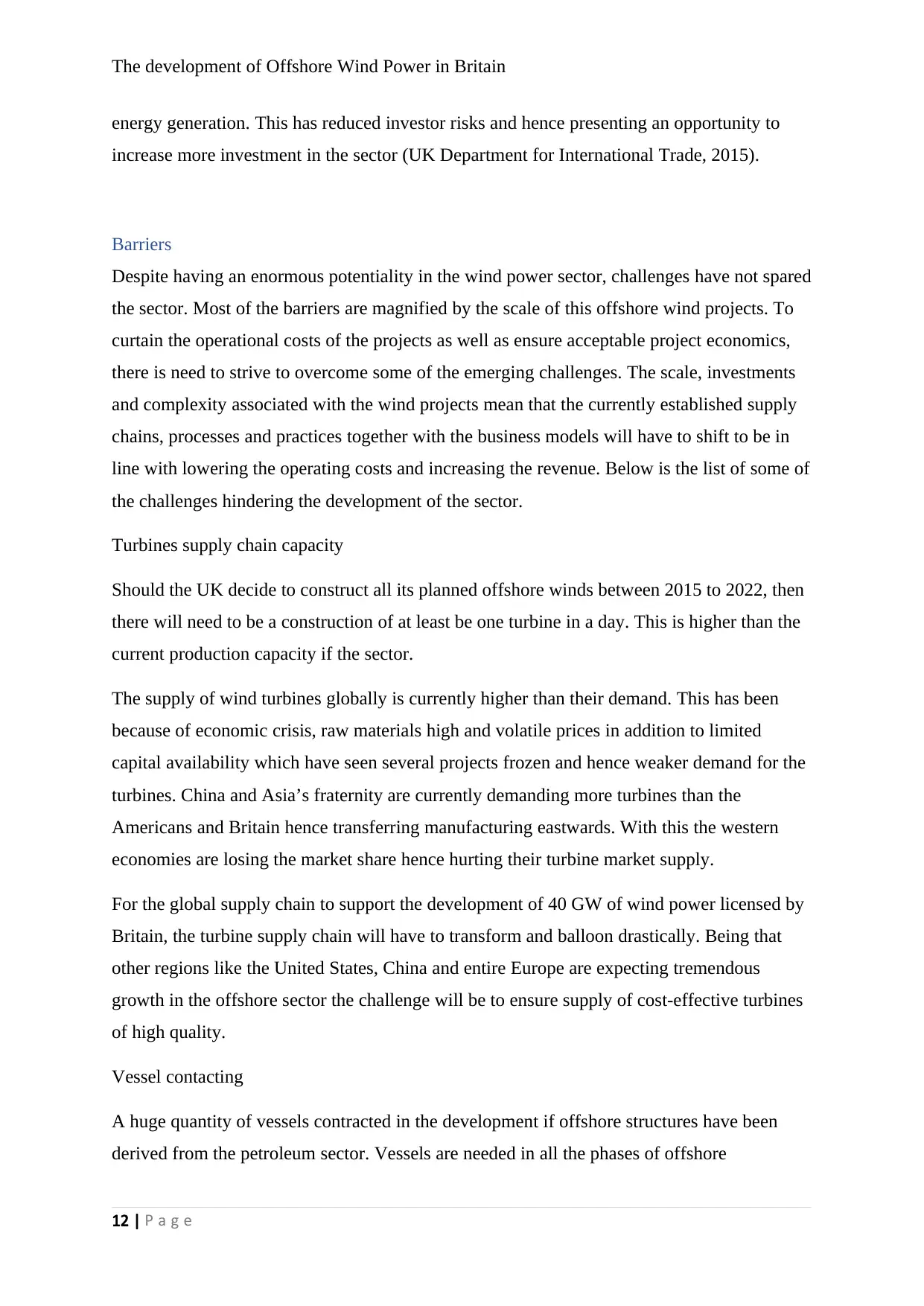
The development of Offshore Wind Power in Britain
energy generation. This has reduced investor risks and hence presenting an opportunity to
increase more investment in the sector (UK Department for International Trade, 2015).
Barriers
Despite having an enormous potentiality in the wind power sector, challenges have not spared
the sector. Most of the barriers are magnified by the scale of this offshore wind projects. To
curtain the operational costs of the projects as well as ensure acceptable project economics,
there is need to strive to overcome some of the emerging challenges. The scale, investments
and complexity associated with the wind projects mean that the currently established supply
chains, processes and practices together with the business models will have to shift to be in
line with lowering the operating costs and increasing the revenue. Below is the list of some of
the challenges hindering the development of the sector.
Turbines supply chain capacity
Should the UK decide to construct all its planned offshore winds between 2015 to 2022, then
there will need to be a construction of at least be one turbine in a day. This is higher than the
current production capacity if the sector.
The supply of wind turbines globally is currently higher than their demand. This has been
because of economic crisis, raw materials high and volatile prices in addition to limited
capital availability which have seen several projects frozen and hence weaker demand for the
turbines. China and Asia’s fraternity are currently demanding more turbines than the
Americans and Britain hence transferring manufacturing eastwards. With this the western
economies are losing the market share hence hurting their turbine market supply.
For the global supply chain to support the development of 40 GW of wind power licensed by
Britain, the turbine supply chain will have to transform and balloon drastically. Being that
other regions like the United States, China and entire Europe are expecting tremendous
growth in the offshore sector the challenge will be to ensure supply of cost-effective turbines
of high quality.
Vessel contacting
A huge quantity of vessels contracted in the development if offshore structures have been
derived from the petroleum sector. Vessels are needed in all the phases of offshore
12 | P a g e
energy generation. This has reduced investor risks and hence presenting an opportunity to
increase more investment in the sector (UK Department for International Trade, 2015).
Barriers
Despite having an enormous potentiality in the wind power sector, challenges have not spared
the sector. Most of the barriers are magnified by the scale of this offshore wind projects. To
curtain the operational costs of the projects as well as ensure acceptable project economics,
there is need to strive to overcome some of the emerging challenges. The scale, investments
and complexity associated with the wind projects mean that the currently established supply
chains, processes and practices together with the business models will have to shift to be in
line with lowering the operating costs and increasing the revenue. Below is the list of some of
the challenges hindering the development of the sector.
Turbines supply chain capacity
Should the UK decide to construct all its planned offshore winds between 2015 to 2022, then
there will need to be a construction of at least be one turbine in a day. This is higher than the
current production capacity if the sector.
The supply of wind turbines globally is currently higher than their demand. This has been
because of economic crisis, raw materials high and volatile prices in addition to limited
capital availability which have seen several projects frozen and hence weaker demand for the
turbines. China and Asia’s fraternity are currently demanding more turbines than the
Americans and Britain hence transferring manufacturing eastwards. With this the western
economies are losing the market share hence hurting their turbine market supply.
For the global supply chain to support the development of 40 GW of wind power licensed by
Britain, the turbine supply chain will have to transform and balloon drastically. Being that
other regions like the United States, China and entire Europe are expecting tremendous
growth in the offshore sector the challenge will be to ensure supply of cost-effective turbines
of high quality.
Vessel contacting
A huge quantity of vessels contracted in the development if offshore structures have been
derived from the petroleum sector. Vessels are needed in all the phases of offshore
12 | P a g e
⊘ This is a preview!⊘
Do you want full access?
Subscribe today to unlock all pages.

Trusted by 1+ million students worldwide
1 out of 17
Related Documents
Your All-in-One AI-Powered Toolkit for Academic Success.
+13062052269
info@desklib.com
Available 24*7 on WhatsApp / Email
![[object Object]](/_next/static/media/star-bottom.7253800d.svg)
Unlock your academic potential
Copyright © 2020–2025 A2Z Services. All Rights Reserved. Developed and managed by ZUCOL.




